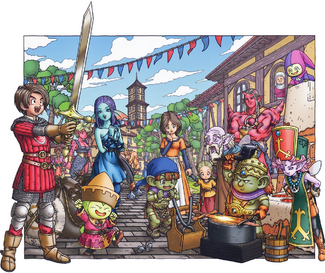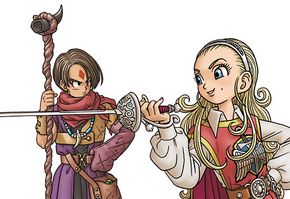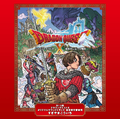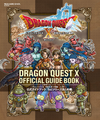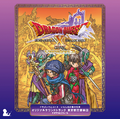Dragon Quest X
Note: This article and many related to it use fantranslated names for simplicity's sake. We aim to use officially translated names where possible.
| Main series games | |
|---|---|
| Awakening of the Five Tribes (Version 1) The Sleeping Hero and the Guiding Ally (Version 2) Legend of the Ancient Dragon (Version 3) The 5,000-year Journey to a Faraway Home (Version 4) The Maiden of Thorns and the God of Destruction (Version 5) Heroes of the Heavenly Stars (Version 6) Door to the Future and the Slumbering Girl (Version 7) | |
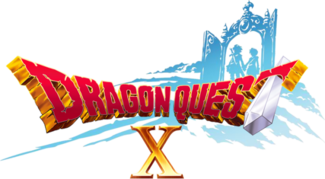
| |
| Developer(s) | Square Enix |
| Publisher(s) | Square Enix |
| Designer(s) | Yuji Horii |
| Artist(s) | Akira Toriyama |
| Composer(s) | Kōichi Sugiyama |
| Series | Dragon Quest |
| Platform(s) | Wii, Wii U, Nintendo 3DS, Microsoft Windows, Android, PlayStation 4, Nintendo Switch |
| Release date(s) | Wii JP August 2, 2012
Wii U JP March 2013 Microsoft Windows JP September 26, 2013 CHN May 20, 2016 Android JP December 16, 2013 |
| Genre(s) | Console role-playing game |
| Rating(s) | CERO: A |
Dragon Quest X: Mezameshi Itsutsu no Shuzoku Online (ドラゴンクエストX オンライン Doragon Kuesuto Ten: Onrain) is the tenth game in the Dragon Quest series. It was announced at a press conference in January 2009. On September 5 2011, it was announced to be an online multiplayer game for the Nintendo Wii and released in Japan on August 2, 2012, and later ported to more platforms such as Wii U, PC or PS4. The starting portion of Dragon Quest X is also playable without the online feature, but to play the full game players need to be online at all times.
Several expansion packs were released for the game: The Sleeping Hero and the Guiding Ally in 2013; Legend of the Ancient Dragon in 2015; The 5,000-year Journey to a Faraway Home in 2017; The Maiden of Thorns and the God of Destruction in 2019; Heroes of the Heavenly Stars in 2021, and Door to the Future and the Slumbering Girl in 2024. A Nintendo Switch version was also announced during the January 12th, 2017 Nintendo Switch Presentation.
The Wii version was discontinued on November 15th, 2017. The Wii U and 3DS versions were discontinued on March 20th, 2024.
Up to this day, Dragon Quest X remains the only mainline Dragon Quest game to not be officially released in English-speaking territories. A Chinese localization was released in 2016, and eventually discontinued in May 2019.
A completely offline version of the game that features the first and second versions of the game, with the latter as paid DLC, was released in Japan on September 15, 2022 and in Eastern Asia on May 28, 2024 with Korean, Simplified Chinese, and Traditional Chinese translations.
Gameplay[edit]
Dragon Quest X is in many ways an evolution of the systems seen in Dragon Quest IX.
DQX is the first game inside the numbered titles that breaks the Dragon Quest tradition of turn-based combat; the combat becomes more action-based by breaking the order of the attacks. The combat is still command-based like in the rest of the main series, but an invisible ATB-like system controls the actions, and player placement and character weight influence the combat. In battle, the actions are similar to in other titles: Attack, Spells, Skills, Items, Misc (Change weapon, Tactics), and Defend; with coups de grâce being selectable when randomly triggered. To flee, players must exit the semitransparent circle that borders the combat area. Outside of combat, players can rearrange their skills and spells for easier access to the actions they use the most.
Dragon Quest X also breaks two other series traditions: the Zoom spell is replaced by the Zoomstone system (similar to the ones that appear in Heroes 2), and the church's main function is linked to them. The inhabitants of Astoltia use Zoomstones to quickly fly to other locations. The number of Zoomstones is quite limited at the start of the adventure, so players need to wisely choose which places to bind their Zoomstones to. Certain cities like Lendor or Megistris have useful npcs who know the Bazoom spell and are able to send players flying to their desired destination, granted they have previously visited it. As Dragon Quest X's saving system allows players to save practically everywhere, priests and nuns now have a new primary function: bind zoomstones to certain locations. They can only link a Zoomstone to where they currently are, so players need to visit each location and talk to the clergy to bind their stones. Aside from their brand new function, the clergy continues to offer their usual revival and antidotal services.
The game includes a quest system like in 'Dragon Quest IX', but with some changes. Quests serve as side-stories helping non-player characters around the game's world. Multiple quests can be accepted simultaneously with some even interlocking and unlocking various stages in fellow quests. Quests can be simple sidestories to give more context or characterization to the inhabitants of the world, increase the level cap, unlock many useful functions and additions such as new hair dyes or new vocations, or give unique rewards such as cosmetics. Like the previous Dragon Quest installment, Dragon Quest X contains many open-ended mini-quests. Upon completion of the quests, a "Quest List log," serves as an in-game achievement list.
There is a vocation system that gives independent levels to each vocation the character can learn, similat to Dragon Quest IX's. Like in IX, there are quests to unlock more specialized vocations like Paladin, Sage or Armamentalist, among other vocations. Each vocation can equip different armor sets, and usually three or four different weapon types. All of them have unique skill trees, well worth investing in. One of the most notable differences with IX's vocation system is that each weapon skilltree must be learned by each vocation, there is not a shared weapon skilltree among vocations that share the same weapon, and there are no ways to bypass the vocation limitation to weapon types. For example, if a player learns the skill Dragon Slash by slotting points to the Warrior's Sword skilltree, when the same player unlocks Armamentalist -another vocation that can use swords-, they will need to invest points to its own Sword skilltree to unlock the skill. In contrast, in DQIX, a warrior in the same situation would already know Dragon Slash when they became Armamentalist.
Aside from vocations, players can choose a job for their character. Each job specializes in a different thing: weapon smithing, armor smithing, tailoring / sewing, toolsmithing, cooking food that gives stat and EXP bonuses for a limited time, and alchemy to add effects to equipment... There are also brand new "Job quests" that can only be received when you have the job that is requested. The Traveler's Bazaar is there to incentivize players to trade their crafted goods.
This game also includes two new features as a reference to other RPG games: the Fire Colosseum and the Magic Labyrinth. The Fire Colosseum allows the player to challenge again some storyline bosses that are modified to be stronger and the Magic Labyrinth acts like the Grotto of Dragon Quest IX. Although the first one is located at the top of a snowy mountain, several labyrinths can be encountered during the gameplay, and in the strangest possible places, like a mirror in the Royal Palace of Grand Zetannia in Rendacia. Unlike grottos, magic labyrinths can be altered by player actions using certain items. This allows players to summon specific bosses to fight. In a way, the Magic Labyrinth coins and cards work like the Fiend keys from Dragon Quest of the Stars.
There is mailing system which allows the developers to communicate important things to players, as well as players to talk with and gift each other.
A mount system exists: the dolboard. This transportation method can be unlocked in the dwarf continent, though nowadays new players can get a free rental one at the start of their adventure if they want. The dolboard can be customized with prism items, which can usually be acquired through events or the cash shop.
Another feature unique to DQX is the housing feature. Players can purchase a lot and put a house in it. There are plenty of cosmetic and functional decorations for the house and garden.
Game features[edit]
- 3D graphics and a real-time overworld similar to those found in Dragon Quest VIII: Journey of the Cursed King, using the Crystal Tools engine.
- Highly customizable characters, with many different faces, skin colors, weapons and armours. This game also included different races such as Ogres, Wetlings, Poppets, Elves and Dwarves. At a certain point in the story, the player unlocks the ability to switch between their original human body and their chosen race's body with the help of priests.
- Co-operative play with up to four players online. Some game modes allow more players at once: for example, the various "Alliance Battles" allow 8 players to cooperate to defeat a strong boss.
- Rental companions that can be recruited for a limited time up to 168 hours. If the target companion is from the same team (guild), their cost is halved. If the target companion is listed as a friend, their costs is free.
- Chat system to allow easy communication between players.
- Guild system for groups of players. Leveling the team grants all members with special rewards, like special team outfits or mounts.
- At certain points of the story, important characters will temporarily join your party as guest party members. They usually only stick for a boss battle or two, however.
- Time-limited events where you can receive cosmetic equipment, emotes and skins for the dolboard.
- A fully customizable house for the player's character.
- Crafting minigames where players can create weapons, armor pieces, clothes, tools, and food using various materials. The smithing minigame used for crafting weapons, armor and tools was later streamlined in Dragon Quest XI's Fun Sized Forge.
- There are multiple quests that are fairly different than most of the substories in the series:
- A parallel storyline where you control a pair of treasure hunter humans exploring long-abandoned ruins filled with puzzles.
- A Japanese high school simulation mode, with character bonding and Visual Novel-style dialogues.
- A murder mystery in a faraway island.
- A brand new fishing minigame, where players fish through simple but exciting turn-based combat.
Offline Storyline[edit]
Offline tutorial and Prologue[edit]
The story begins in the village of Tenton, the home of the Hero and their sibling, when the Hero is looking at the sky at the center of the village. Their sibling calls them, and is shown to be riding the Galapogod along with Tenda, the village's priestess and elder. When the Galapogod reaches the Hero’s location, their sibling offers them a ride, but is immediately interrupted by Tenda, denying the Hero the opportunity.
A strange noise awakens the Hero from the apparent dream, only to learn that their sibling accidentally destroyed the village's supply of Perky Beans, Tenda's favorite food, in an attempt to multiply them via alchemy. At Tenton's church the Hero meets Tenda's grandson, Singh, who instructs the Hero to gather various items from the local villagers, in order to fashion a pillow to serve as compensation for the loss of the Perky Beans. Upon receiving the pillow, Tenda asks the Hero to look for their sibling, and despite being upset at Singh for disturbing her, she still uses the pillow they made, falling into a deep sleep. After locating their sibling successfully synthesizing a hat, the Hero returns to the village, where Tenda announces that she has received an omen from the Galapogod: the village will soon be destroyed, with no survivors. However, hope remains in the form of a plant known as the Tensu Flower, which blooms in a cave to the north. The Hero, their sibling and Singh are chosen to retrieve it. Arriving at the cave, Singh mentions that Tenda had earlier mentioned that even if the Tensu Flower was successfully retrieved, only one person would survive the destruction of Tenton. The Hero’s sibling is shocked at this revelation, but Singh quickly points out the possibility that Tenda was only referring to a worst-case scenario, and the party continues further into the cave.
The party reaches a large chamber at the back of the cave, where several Tensu Flowers are in full bloom. Unfortunately, they are not alone, as the flowers are immediately attacked by a demonic mage named Bedorā. Singh tells him to stop, but Bedorā has no intention of giving even a single flower to anyone capable of crossing through time. Singh is confused by Bedorā’s words, causing him to cackle at how the people of Tenton allowed themselves to forget something so important. He attacks the trio, but loses. Despite his body at its limit, Bedorā swears to fulfill his master’s orders and unleashes one final attack on the Tensu Flowers, decimating them moments before dying. Singh inspects the ruined flowers, and as he does so, recalls an old text he had read, of how the people of Tenton had a spell to travel freely through time in an age long past. Unfortunately, the number of people able to use the spell dwindled, and the spell was lost entirely in the span of several hundred years. As Singh prepares to give up and return to the village, the Hero’s sibling notices a glowing light, obscured by smoke. In a stroke of immeasurable luck, one of the Tensu Flowers had survived.
However, by the time the party returns to the village, they find a horde of monsters burning everything to the ground. A stray fireball flies towards the Hero’s sibling, causing both the Hero and Singh to panic. The Hero reaches out to their sibling, who is then immediately surrounded by a bright light, with their surroundings frozen, as if time itself had stopped; the Hero had unknowingly cast the ancient spell to cross time. The Hero’s sibling immediately disappears, leaving no indication as to where or when they were sent. A monster witnessing the event quickly notifies his master, Nelgel the Netherlord, who was supervising the attack. Nelgel is far from surprised that there was still someone who could travel through time, as he suspected as such, to begin with. He immediately kills the Hero and every remaining villager in Tenton, although the Galapogod remains unharmed, due to its innate ability.
With his goal accomplished, Nelgel retreats to the skies above. Using his scythe, he opens a dark portal where an ominous cloud spills out, completely covering the central continent, Rendacia. Five lights appear from the Galapogod’s body, flying over the deceased bodies of Tenton’s villagers, until one of them stops over the Hero’s body. With the Hero’s soul in tow, the light immediately departs for the Room of Revival off in the distance.
The Hero's soul awakens, and they are greeted by a voice, which explains that five gods, representing the five races of Astoltia, are willing to reincarnate them into a new body. Upon choosing a race and appearance, the Hero is given an Adventure Log to record their travels and is sent to the world of Astoltia to seek out their destiny.
Extended campaign[edit]
Version 1: Awakening of the Five Tribes[edit]
Plot[edit]
Version 2: The Sleeping Hero and the Guiding Ally[edit]
Plot summary[edit]
The story of Version 2 picks up where Version 1 ended: now that Rendacia is free from Nelgel's seal, it's time to visit it and find the Hero with the help of the mysterious Klaus and the inhabitants of Rendacia.
After finding and awakening Hero Anlucia, the player quickly realizes his role as the Hero's Ally, a key supportive figure for the Hero. Anlucia and her ally will set out to defeat the Great Archfiend Maldragora, who made Nelgel seal Rendacia.
Version 3: Legend of the Ancient Dragon[edit]
Plot summary[edit]
In the second expansion of Dragon Quest X, the player travels to the land of Nadragand, where the dragon people (nadravians) live. Some dear friends from all continents have been kidnapped by a mysterious nadravian. Not long after reaching the first of the five realms of Nadragand, the player is labeled a "liberator" by the priests of The Nadraga, the ruling class in the fire realm. The priests task the liberator with connecting the five realms together.
This expansion gives an insight on the creation of Astoltia and Nadragand and the conflict between the two, as well as the creation of the seven races: nadravian, dwarf, ogre, wetling, poppet, elf and human.
Version 4: The 5,000-year Journey to a Faraway Home[edit]
Plot summary[edit]
While playing with a tool obtained from a certain survivor of Tenton, the player is transported many years to the past, to a mysterious mansion that works with strange technology. Soon after, Mereade -the lady of the mansion- will warn the main character of the impending doom of the world in their present time and send him to the present, where he must warn his allies and find ways to stop the certain doom they face.
This expansion gives us a deeper look into the time-traveling powers of the main character and their origins.
Version 5: The Maiden of Thorns and the God of Destruction[edit]
Plot summary[edit]
After a hard battle at the gates of hell, the main character is gravely hurt. Seeing him, Shaka -a mysterious red-haired demon- takes him to the Netherworld and revives him by using a forbidden technique: sharing blood with him, which turns him into a demon whom Shaka considers his servant. Shaka's goal is to become the next Great Archfiend after the defeat of Maldragora by the hands of Anlucia and her Ally, and he will make the Hero play along with his plans.
This arc centers on the conflict between the creator goddess of Astoltia -Luciana- and the Great Source of Darkness -Jagonuba-.
Version 6: Heroes of the Heavenly Stars[edit]
Plot summary[edit]
An unknown floating city has appeared in the skies of Lendor. Doctor Palmio, a genious Poppet, tells you this strange city appears each time the world has been saved from a disaster. When the Hero and Palmio try to reach the city with a flying device invented by the poppet, the inhabitants of the flying city attack them. After the confrontation, an angel named Yuliza invites the Hero, the new Champion, to enter the city. There, the Hero meets heroes from other times who saved their civilizations.
Version 7: Door to the Future and the Slumbering Girl[edit]
Plot summary[edit]
|
|
This article is a stub. You can help by expanding it. |
Dragon Quest X Offline[edit]
An offline version of Dragon Quest X was announced on May 26, 2021, as part of the Dragon Quest 35th Anniversary livestream. This version is a separate release from the original, with different gameplay and aesthetics.
Developed by Bandai Namco Entertainment studio B.B. Studio, using Unreal Engine 4, Dragon Quest X Offline features gameplay similar to Dragon Quest XI, including a turn-based battle system with a Finishing Move gauge to unleash special moves; a Character Builder system with skill trees; and the series's traditional Vocation system. After clearing the game, players will receive a special Spell of Restoration to be used in Dragon Quest X Online, which allows them to start the story with all levels at 70.[1]
Dragon Quest X Offline was originally announced to be released in Japan on February 26, 2022, with a downloadable expansion based on The Sleeping Hero and the Guided Allies set for a Spring 2022 launch.[2] However, it was delayed to Summer 2022 for quality improvements, with the expansion postponed to Fall 2022.[3]
Manga[edit]
There are three manga series inspired by DQ10:
- Dragon Quest: Souten no Soura, an adventure series set in the world of Astoltia, following Soura, a wetling boy.
- Rooming with a Gamer Gal, a romance-comedy manga set in the real world, follows two DQ10 players who begin living together.
- Dragon Quest X 4Koma, a short series of 4koma style humorous strips.
Gallery[edit]
The original Dragon Quest's 30th anniversary.
References[edit]
- ↑ "Dragon Quest X Offline details guest characters, original episode, and Spell of Restoration". Gematsu. December 29, 2021.
- ↑ "Dragon Quest X Offline launches February 26, 2022 in Japan for PS5, PS4, Switch, and PC". Gematsu. October 3, 2021.
- ↑ "Dragon Quest X Offline delayed to summer 2022 in Japan". Gematsu. December 26, 2021.
